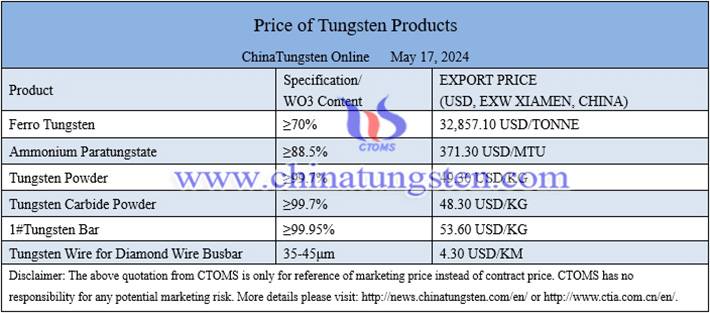Analysis of Tungsten Market Trends and Macroeconomic Factors in 2024
- Details
- Category: Tungsten's News
- Published on Friday, 17 May 2024 14:52
Analysis of latest tungsten market from Chinatungsten Online
According to the statistics from Chinatungsten Online, as of May 16, 2024, the price of 65% black tungsten concentrate has reached $22,142.9/ton. This current upward cycle has been ongoing for six months (with the lowest point of the previous cycle being $17,000.0/ton on November 15, 2023), resulting in a cumulative increase of 30%. Specifically, compared to the beginning of 2024, the price has risen by 26%.
Historically, there have been two points higher than this price level: $22,357.1/ton on May 9, 2011, and $22,214.3/ton on September 1, 2011. At those times, the prices of ammonium paratungstate (APT) were $386.3/mtu and $390.6/mtu respectively, while the prices of tungsten powder were $53.1/kg and 53.9/kg respectively.
Chinatungsten Online analysis indicates that the peak of tungsten product prices in 2011 was mainly due to the global financial storm caused by the economic aftermath of the 2008 Wenchuan earthquake in China and the subprime mortgage crisis following the bankruptcy of Lehman Brothers in the United States. At the end of that year, China launched a 4 trillion yuan economic stimulus policy to vigorously promote domestic demand markets such as real estate, leading to a surge in demand for tungsten products in related industries such as iron, public infrastructure, and real estate. By May 2011, property prices had doubled, and the Shanghai Composite Index had risen from 1664 points to a peak of 3478 points, doubling in value. The industries with the largest increases included non-ferrous metals, mining, building materials, automobiles, and real estate, reflecting the demand for tungsten products brought about by the forceful push of the 4 trillion yuan investment in the iron, public infrastructure, and real estate sectors.
As can be seen from the twenty-year trend chart of tungsten prices compiled by Chinatungsten Online, the rebound cycle of tungsten prices after hitting bottom in the 2008 financial crisis lasted for more than two years (excluding minor fluctuations during this period). By the peak in 2011, the cumulative increase in tungsten prices was 163%. Following this, there was a roughly 22% decline over the course of a year. Subsequently, a new round of enterprise stocking cycles drove the price of tungsten concentrate up by 22% the following year. Subsequent events such as the Pan-Asian crisis and the categorization of tungsten slag as hazardous waste have caused significant fluctuations in tungsten product prices, but these are not detailed here.
Analysis by Chinatungsten Online suggests that, based on the macroeconomic background reflected in the price statistics table above, the main macroeconomic factors influencing the current tungsten market are as follows:
1.China's continued efforts to promote new quality production after the epidemic;
2.The almost complete removal of real estate purchase restrictions and sales restrictions since the beginning of this year, along with urban housing reform, government land purchases, and other policies, will drive a new round of real estate development. The replacement of new types of housing and improved housing will bring new opportunities for tungsten product consumption across the entire real estate industry chain;
3.New technological industrialization of AI, new energy vehicles, new energy generation, and large aircraft projects, as well as the gradual entry of high-speed rail into maintenance and renewal periods, and the accelerated application of industrial robots, will bring significant demand for tungsten products in industries such as electrical power, tools, and molds;
4.China's overall foreign trade situation is positive, with exports of electromechanical, semiconductor, information industry, and new energy products increasing significantly compared to traditional consumer goods, resulting in significant consumption and inventory accumulation of tungsten products in various industry chains;
5.Escalating conflicts in regions such as Russia, Ukraine, and Ethiopia have highlighted the financial attributes of copper, aluminum, nickel, and other non-ferrous metals. These conflicts have also accelerated the consumption of tungsten resources in the global military field, increasing the pressure on relevant entities to stockpile and purchase actively;
6.Loose and even excessive global monetary policies since the epidemic, as well as inflation spillovers caused by continuous quantitative easing and debt issuance led by the United States and Japan, have resulted in rising prices of globally traded commodities;
7.China's positive legal and regulatory policy environment regarding environmental protection, carbon neutrality, and labor protection, as well as strict enforcement efforts, have endowed tungsten products and all metal smelting products with increasingly higher environmental protection costs;
8.The explosive growth of cross-border e-commerce has provided unprecedented global retail markets for China's medium and low-end tools and general industrial products. The addition of new processing capacity has provided new market shares for cemented carbide tools.
Prices of tungsten products on May 17, 2024

Picture of tungsten needles

Follow our WeChat to know the latest tungsten price, information and market analysis.

- Tungsten Manufacturer & Supplier, Chinatungsten Online: www.chinatungsten.com
- Tungsten News & Prices of China Tungsten Industry Association: www.ctia.com.cn
- Molybdenum News & Price: news.molybdenum.com.cn
- Tel.: 86 592 5129696; Email: sales@chinatungsten.com



 sales@chinatungsten.com
sales@chinatungsten.com